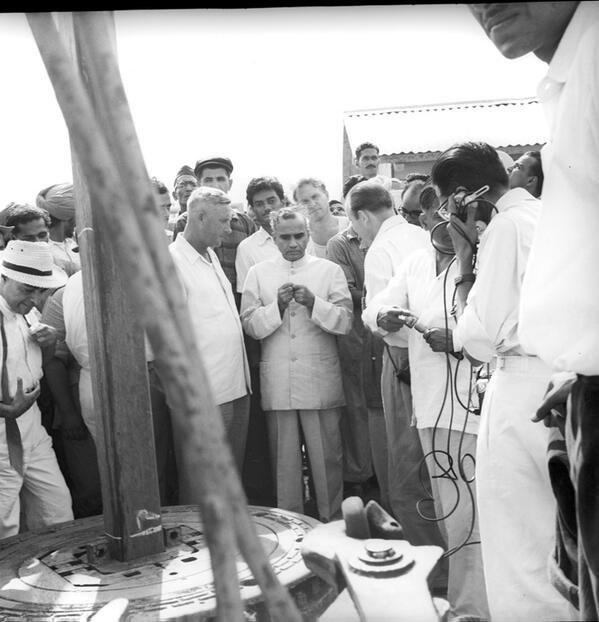
Achieving self-sufficiency in domestic oil production has been the recurring Indian dream since mid-1950s. The then Petroleum minister, KD Malaviya, whose untiring efforts led to the birth of ONGC, had set his heart on making India self-sufficient in petroleum energy, writes Raj Kanwar
It goes to his credit that he did achieve some success with the discovery in quick succession of three on-land oilfields. First of these discoveries came in Cambay in September 1958; less than two years later, a much bigger oilfield was discovered in Ankleshwar in May 1960. Both these discoveries were made in Gujarat. And a few months thereafter in December, a hat-trick was performed with the discovery of Rudrasagar field in Assam.
Though the discovery of a few small and medium-sized oil and gas fields at that time in Gujarat and Assam did not justify such exuberance, yet it was the beginning in the right direction. However, it was the discovery later of the relatively high-yielding Bombay High field on 20 May 1976 that had caused countrywide jubilation and justifiably so.
Perspective Plan 2030
Ten years ago on 28 May 2012, ONGC’s Board of Directors had approved an ambitious PERSPECTIVE PLAN (PP) 2030 that had aimed at, among other objectives, enhancing by 2030 its domestic oil production by five per cent. Sudhir Vasudeva was then its Chairman & Managing Director.
For the record, ONGC had produced a total of 20.5 Million Metric Tonnes (MMT) of domestic crude in the year 2012-13. Thus the five per cent stipulated increase should take India’s domestic production to 21.52 MMT by 2030. However, during the 10 years that have since elapsed instead of rising, its production paradoxically has fallen by nearly two million metric tonnes to 18.5 MMT in 2021-22. And thus goes for a toss ONGC’s dream of enhancing domestic production.
The Perspective Plan 2030 that aimed at increasing the domestic production by five per cent had only been in operation for barely eight years when ONGC Board under the chairmanship of Shashi Shanker introduced in April 2019 the new Energy Strategy 2040 that aimed at, among other objectives, doubling of the domestic oil and gas production by 2040.
Is then the decision by ONGC of doubling the oil production in the country a reality or just a pipe dream? Oil production in India both offshore and onshore has been seen many ups and downs, downs and ups, but largely downs and downs.
Way back in 1947, India’s domestic production of crude was minuscule 2,50,000 metric tonnes – all from Assam. In the following 13 years i.e. by 1960-61, it rose to 4,50,000 metric tonnes – a negligible increase of barely 2,00,000 metric tonnes. Twenty years later in 1980-81, its production was 10.51 MMT. And in another 10 years i.e. by 1990-91, the country’s domestic production stood at 33.02 MMT– an impressive increase of 22.51 MMT. However, surprisingly it fell to 32.45 MMT in the year 2000-2001 – a decrease of 0.57 MMT. In the following 10 years i.e. by 2009-10, it decreased to 31.40 MMT – a decline of 1.05 MMT. The declining trend unfortunately and paradoxically continued, and the domestic production further fell to 28.40 MMT in 2021-22 – a sharp decline of three MMT.
26 Sedimentary Basins in India
IT is a universal geological dictum that oil is mostly accumulated in sedimentary rocks. In India there are 26 Onshore and Offshore Sedimentary Basins, covering an area of 3.36 million square kilometers, 1.63 million square kilometers, i.e. 49% of the total area, is onshore, while 0.41 (zero point four one) million square kilometer i.e. 12% is in shallow water and the remaining 1.32 million square kilometers i.e. 39% in ultra deep sectors. These Basins were divided into three categories based on the maturity of their hydrocarbon resources viz. Category-I, II and III as per a Hydrocarbon Resource Re-Assessment Study carried out in 2017. Category-I Basins have already established commercial production of hydrocarbons while Category-II Basins have made discoveries but their commerciality is yet to be established. And the Category-III Basins have prognosticated resource potential, but discoveries are yet to be made.

In the Category I, there are seven Basins namely Cambay, Assam Shelf, Bombay Offshore, Krishna Godavari, Cauvery, Assam Arakan Fold Belt and Rajasthan covering a total area of 9,98,325 square kms that have been under commercial production since 1958. It is the Category I Basins that today produce virtually all of India’s crude. And if the domestic production is to be increased, it is only the Category I Basins from where it would need to be optimized. However, that seems like an improbable task; the cumulative production that was 20.8 MMT in 2014-15 in the Category I Basins had sharply declined to 18.50 MMT, by nearly 7.7 per cent in 2021-22.
Like flogging a dead horse
THE reasons are obvious. Most of the onshore fields of ONGC are more than 50 years old with declining yields. The high producing Bombay Offshore fields too are 46 years old. Thus even to bring about any incremental increase in the production of these ageing fields is like flogging a dead horse.
In the Category II with a total Basinal area of 7,80,974 square kms, roughly 23 per cent, there are five Basins viz Vindhyan, Kutch, Saurashtra, Mahanadi and the Andaman Islands that have known accumulation of hydrocarbons.
The Category III with 14 Basins cover a total area of 15,86,150 square kms or 47 per cent. These are Kerala-Konkan, Bengal, Ganga, Pranhita-Godavari, Satpura-South Rewa and Damodar, Himalayan Foreland, Chhattisgarh, Narmada, Deccan, Bastar et al. Even though the Bengal onland field has recently been put on commercial production, it is not expected to add much to India’s domestic oil kitty.
Thus in desperation, ONGC Board at its meeting on 26th May firmed up its “Future Exploration Strategy” that would further explore the Indian Sedimentary Basins over the following three fiscal years 2022-2025 at a cost of Rs 31,000 crore for discovering additional ‘Fuel Reserves’. It is beyond one’s comprehension why ONGC has earmarked the enormous amount of Rs 31,000 crore on ‘further exploring the Indian Sedimentary Basins’ when it has already explored to its bone the Category I Basins. Here it needs to be pointed out that it is the only Category I Basins that have enough oil and gas reserves. The remaining Basins in Category II and III barely have any oil and gas reserves to write about.
What is the way out for ONGC?
WHAT is then the way out for ONGC? It is here that ONGC’s wholly-owned subsidiary ONGC Videsh Limited (OVL) needs to be further strengthened and made more aggressive in its overseas operations. Currently OVL has its footprints in 15 countries such like Brazil, Colombia, Bangladesh, Azerbaijan, Libya, Myanmar, Russia, South Sudan, Syria, Vietnam et al. It has developed strong partnership alliance with a host of International and National Oil Companies such as ExxonMobil, British Petroleum, Petrobras, Rosneft, Petro Vietnam, Petronas, Abu Dhabi National Oil Company et al.
Fortuitously, ONGC Videsh has already developed oil and gas production from 14 of its Assets. In four of these Assets, hydrocarbons have been discovered, and are at various stages of development. Now under the leadership of its dynamic new managing director Rajarshi Gupta, OVL is bound to go places. Thus what ONGC now needs is to take a piggyback ride on OVL’s back and convert itself into a major international oil operator and substantially expand its presence in most of these countries.













